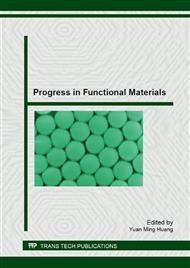p.185
p.189
p.193
p.197
p.201
p.205
p.211
p.215
p.219
Two-Dimensional Silicon Nitride Photonic Crystal Band Gap Characteristics
Abstract:
Plane-wave expansion method was employed to analyze the photonic band gap in two-dimensional silicon nitride photonic crystal. The effects of filling ratio and lattice structure type on the photonic band gap were studied. The results showed that two-dimensional dielectric cylinder type silicon nitride photonic crystal only has TE mode band gap, while, the air column type photonic crystal has complete band gap for TE and TM modes simultaneously. The distribution of band gap can be influenced by the filling ratio of dielectric materials and the lattice type. It is shown that the triangular lattice structure is much easier to form band gap than square lattice structure.
Info:
Periodical:
Pages:
201-204
Citation:
Online since:
January 2013
Price:
Сopyright:
© 2013 Trans Tech Publications Ltd. All Rights Reserved
Share:
Citation:


